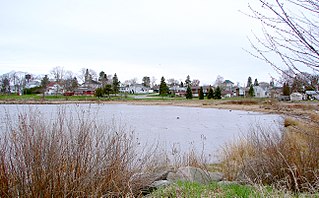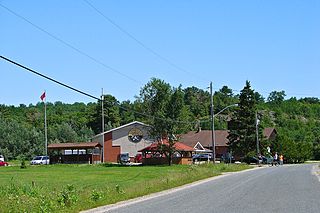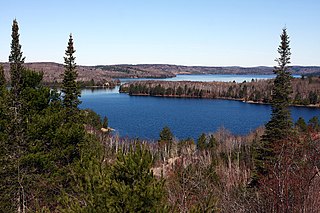
Elliot Lake is a city in Algoma District, Ontario, Canada. It is north of Lake Huron, midway between the cities of Sudbury and Sault Ste. Marie in the Northern Ontario region. Once dubbed the "uranium capital of the world," the closure of the uranium mines led to a population collapse of over 40% since the peak in 1986. Elliot Lake has since diversified to a hub for forest harvesting, mine reclamation expertise, and advanced manufacturing. Elliot Lake is now known as a place for affordable retirement living.

Blind River is a town situated on the North Channel of Lake Huron in the Algoma District, Ontario, Canada. The town, named after the nearby Blind River, celebrated its centennial in 2006.

The North Shore is a township in the Canadian province of Ontario, located in the Algoma District. The township had a population of 497 in the Canada 2016 Census. It is along the north shore of the North Channel of Lake Huron, with its main communities all along Highway 17.
Wilfrid Laurier University Press, based in Waterloo, Ontario, is a publisher of scholarly writing and is part of Wilfrid Laurier University. The fourth-largest university press in Canada, WLUP publishes work in a variety of disciplines in the humanities and social sciences — literary criticism, indigenous studies, sociology, environmental studies, and history among them — as well as books of regional interest. Laurier Press also provides publishing services to scholarly associations and journals.

Madawaska Mine (previously known as Faraday Mine) is a decommissioned underground uranium mine in Faraday, near the town of Bancroft, Ontario, which produced 9 million pounds (4,082 tonnes) of U3O8 concentrate, at an average ore grade of 0.1074%, during its two periods of production.

Christi Marlene Belcourt is a Métis visual artist and author living and working in Canada. She is best known for her acrylic paintings which depict floral patterns inspired by Métis and First Nations historical beadwork art. Belcourt's work often focuses on questions around identity, culture, place and divisions within communities.
The Spanish American Mine is a historical uranium mine located approximately 11 km (7 mi) northeast of Elliot Lake, Ontario, owned and operated by Rio Algom Ltd. The site is 2.3 km (1 mi) southeast of the Denison Mine.
The Pronto Mine is an historical uranium mine located approximately 20 km south of Elliot Lake, Ontario near Spragge. The site is owned and operated by Rio Algom Ltd, has been rehabilitated and is currently undergoing environmental monitoring.

Canada is the world's second largest producer of uranium, behind Kazakhstan. In 2009, 20% of the world's primary uranium production came from mines in Canada. 14.5% of the world production came from one mine, McArthur River. Currently the only producing area in Canada is northern Saskatchewan, although other areas have had active mines in the past.

The Serpent River First Nation, a signatory to the Robinson Huron Treaty of 1850, is an Anishinaabe First Nation in the Canadian province of Ontario, located midway between Sault Ste. Marie and Sudbury along the North Channel of Lake Huron.
Barry Morton Gough is a global maritime and naval historian.
Assabaska is a Saulteaux First Nation reserve in northwestern Ontario on Lake of the Woods. It is shared between the Big Grassy First Nation and the Ojibways of Onigaming First Nation.
David T. McNab is a Métis historian. He is a professor at York University and cross-appointed in the departments of Equity Studies and Humanities in the Faculty of Liberal Arts and Professional Studies. McNab works on Aboriginal land and treaty rights issues in Canada and as a claims advisor.
The Mica Bay Incident was a land and resources dispute in along the shore of Lake Superior in November 1849. It is partially responsible for the signing of the 1850 Robinson-Huron Treaty.
Kim Anderson was born and raised in Ottawa, Ontario. Her parental grandmother, Catherine Anne Sanderson (b.1902) was the granddaughter of the Métis voyageur, Thomas Sanderson. Her parental grandfather, James E. Anderson (b.1899), came from a long line of marriages among Indigenous peoples spanning over five generations. Kim Anderson's work in educational tourism, community-based education, and cross cultural education afforded her many travels in her youth. But, when became a mother in 1995, she began to research and write about motherhood and culture-based understandings of Indigenous womanhood.

Dyno Mine is a decommissioned underground uranium mine located at Cardiff, near Farrel Lake, approximately 30km southwest of Bancroft, Ontario. It operated from 1958 to 1960.

Uranium mining around Bancroft, Ontario, was conducted at four sites, beginning in the early 1950s and concluding by 1982. Bancroft was one of two major uranium-producing areas in Ontario, and one of seven in Canada, all located along the edge of the Canadian Shield. In the context of mining, the "Bancroft area" includes Haliburton, Hastings, and Renfrew counties, and all areas between Minden and Lake Clear. Activity in the mid-1950s was described by engineer A. S. Bayne in a 1977 report as the "greatest uranium prospecting rush in the world".

Uranium mining in the Elliot Lake area represents one of two major uranium-producing areas in Ontario, and one of seven in Canada.

Quirke Lake is body of water located in Ontario, Canada. It is located in the Quirke Lake basin, a geological basin the northern part of the Huronian Supergroup. The lake is proximate to five decommissioned uranium mines.










